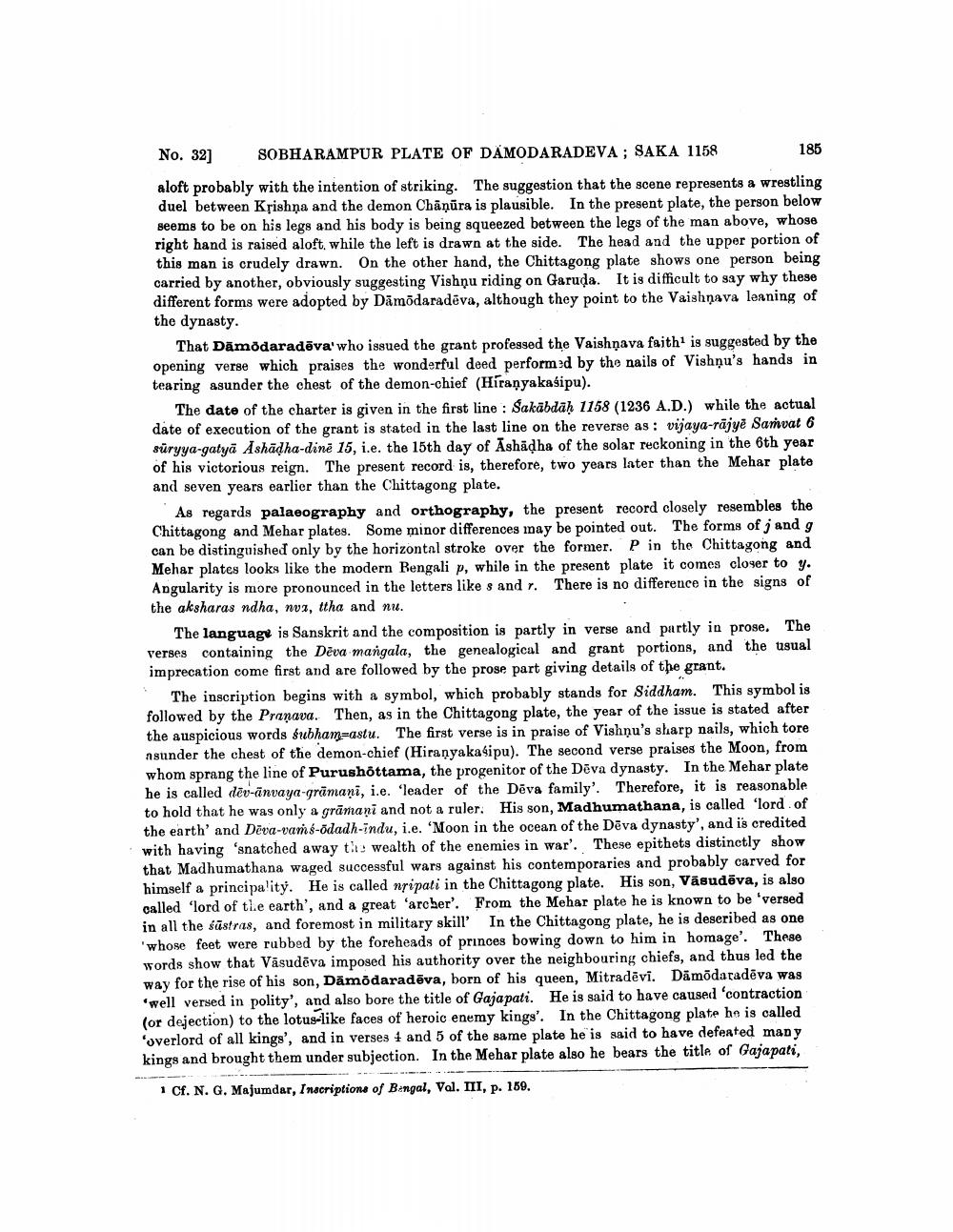________________
185
No. 32] SOBHARAMPUR PLATE OF DAMODARADEVA ; SAKA 1158 aloft probably with the intention of striking. The suggestion that the scene represents a wrestling duel between Krishna and the demon Chänūra is plausible. In the present plate, the person below seems to be on his legs and his body is being squeezed between the legs of the man above, whose right hand is raised aloft, while the left is drawn at the side. The head and the upper portion of this man is crudely drawn. On the other hand, the Chittagong plate shows one person being carried by another, obviously suggesting Vishnu riding on Garuda. It is difficult to say why these different forms were adopted by Damodaradēva, although they point to the Vaishnava leaning of the dynasty.
That Damodaradēva'who issued the grant professed the Vaishnava faith is suggested by the opening verse which praises the wonderful deed performed by the nails of Vishņu's hands in tearing asunder the chest of the demon-chief (Híranyakasipu).
The date of the charter is given in the first line : Sakābdah 1158 (1236 A.D.) while the actual date of execution of the grant is stated in the last line on the reverse as : vijaya-räjyê Samvat 6 süryya-gatyā Ashādha-dine 15, i.e. the 15th day of Ashädha of the solar reckoning in the 6th year of his victorious reign. The present record is, therefore, two years later than the Mehar plate and seven years earlier than the Chittagong plate.
As regards palaeography and orthography, the present record closely resembles the Chittagong and Mehar plates. Some minor differences may be pointed out. The forms of j and g can be distinguished only by the horizontal stroke over the former. P in the Chittagong and Mehar plates looks like the modern Bengali p, while in the present plate it comes closer to y. Angularity is more pronounced in the letters like s and r. There is no difference in the signs of the aksharas ndha, num, ttha and nu.
The languagv is Sanskrit and the composition is partly in verse and partly in prose. The verses containing the Deva mangala, the genealogical and grant portions, and the usual imprecation come first and are followed by the prose part giving details of the grant.
The inscription begins with a symbol, which probably stands for Siddham. This symbol is followed by the Pranava. Then, as in the Chittagong plate, the year of the issue is stated after the auspicious words subham-astu. The first verse is in praise of Vishnu's sharp nails, which tore asunder the chest of the demon-chief (Hiranyakasipu). The second verse praises the Moon, from whom sprang the line of Purushottama, the progenitor of the Döva dynasty. In the Mehar plate he is called dēv-anvaya-grāmani, i.e. 'leader of the Dēva family'. Therefore, it is reasonable to hold that he was only a grāmani and not a ruler. His son, Madhumathana, is called 'lord of the earth' and Deva-vam 6-odadh-indu, i.e. 'Moon in the ocean of the Dēva dynasty', and is credited with having 'snatched away the wealth of the enemies in war'. These epithets distinctly show that Madhumathana waged successful wars against his contemporaries and probably carved for himself a principality. He is called nripati in the Chittagong plate. His son, Vāsudēva, is also called 'lord of the earth', and a great 'archer'. From the Mehar plate he is known to be 'versed in all the süstras, and foremost in military skill' In the Chittagong plate, he is deseribed as one 'whose feet were rubbed by the foreheads of princes bowing down to him in homage'. These words show that Väsudēva imposed his authority over the neighbouring chiefs, and thus led the way for the rise of his son, Damodaradēva, born of his queen, Mitradēvi. Damodaradeva was 'well versed in polity', and also bore the title of Gajapati. He is said to have caused 'contraction (or dejection) to the lotus-like faces of heroic enemy kings'. In the Chittagong plate ho is called 'overlord of all kings', and in verses 4 and 5 of the same plate he is said to have defeated many kings and brought them under subjection. In the Mehar plate also he bears the title of Gajapati.
1 Cf. N. G. Majumdar, Inscriptions of Bengal, Vol. III, p. 169.




